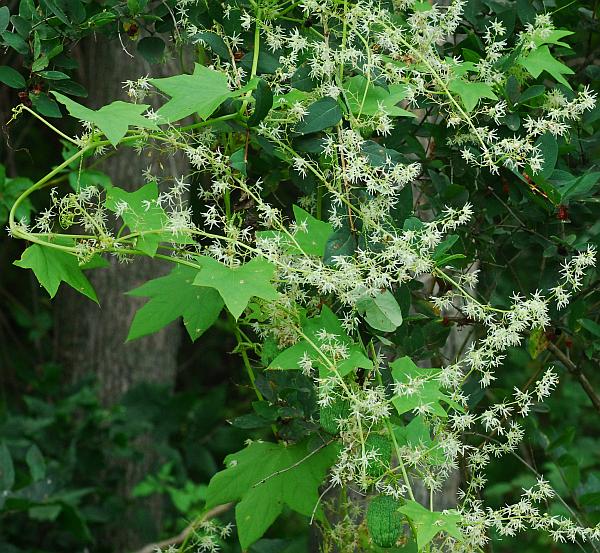Echinocystis lobata (Michx.) Torr. & A. Gray
Wild Cucumber Vine

Native
CC = 5
CW = 0
MOC = 19
© SRTurner
Echinocystis lobata (Michx.) Torr. & A. GrayWild Cucumber Vine | |
 |
Native CC = 5 CW = 0 MOC = 19 |
© SRTurner |
|
Family - Cucurbitaceae Habit - Monoecious annual vine with slender taproot. Stem - To 5 m or more long, slender (1-2 mm in diameter), glabrous, not roughened, the tendrils branched.
Leaves - Alternate, simple, long-petiolate. Petioles 1-4 cm long, lacking glands at the tip, glabrous or nearly so. Leaf blades 2-8 cm long, 3-12 cm wide, broadly ovate to nearly circular in outline, palmately moderately 5-lobed, the lobes triangular to oblong-triangular, with sharply pointed tips and mostly narrowly rounded (less than 90°) sinuses, cordate at the base, the margins otherwise sparsely toothed, the surfaces glabrous or slightly to moderately roughened with minute, nonsticky, pustular-based hairs (often only the small, hardened bases apparent).
Inflorescence - Flowers solitary or in small, few-flowered clusters (pistillate) or in well-developed racemes or racemelike panicles (staminate) 8-14 cm long in the leaf axils, the main stalk of the pistillate inflorescence 2-5 mm long, the clustered flowers with individual stalks 1-5 mm long.
Flowers - Calyx lobes 1.0-1.5 mm long. Corollas 8-12 mm wide, saucer-shaped to broadly bell-shaped, the usually 6 lobes 3-6 mm long, white to creamcolored. Staminate flowers with the filaments fused into a tube, the anthers usually free. Pistillate flowers usually lacking staminodes, the ovary with usually 2 ovules per placenta, the stigma bluntly 2-or 3-lobed.
Fruit - Solitary, thin-walled berries, more or less inflated and juicy at first but becoming dry and fibrous inside a papery wall at maturity, dehiscing irregularly at the tip with age, 2.0-3.5 cm long, ovoid or ellipsoid, with a stalk 9-35 mm long, the surface green, covered with slender, relatively soft, straw-colored to pale yellow prickles 3-6 mm long, otherwise glabrous. Seeds usually 4, 12-20 mm long, 6-9 mm wide, elliptic-obovate in outline above a short, stalklike base, flattened, usually pointed at the tip, the surface otherwise shallowly and irregularly pitted, dark brown, often finely mottled.
Flowering - June - October. Habitat - Streambanks, bottomland forests, roadsides, disturbed areas. Origin - Native to the U.S. Lookalikes - Distantly, Sicyos angulatus. Other info. - This interesting plant is not particularly common in Missouri, and is found mainly in the western portion of the state. It also occurs across the continental U.S. but is mostly restricted to the northern half of the country. It is easily recognized by its showy inflorescences of numerous flowers and its peculiar spiny fruits. It is sometimes grown as an ornamental on arbors and trellises for its showy staminate inflorescences and attractive foliage and fruits. When young, the fruits have a spongy, rubbery texture. After maturing they burst at the tip, violently expelling the seeds under hydrostatic pressure. Native Americans used an infusion of the plant to treat fevers, rheumatism, headaches, and general pain, and as an abortifacient. Photographs taken in Fremont, Newaygo County, MI, 8-31-2014, 9-14-2014 and 9-24-2021 (SRTurner). |